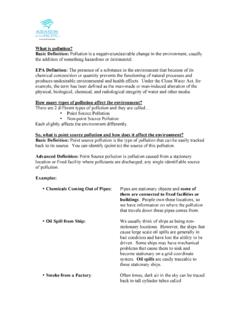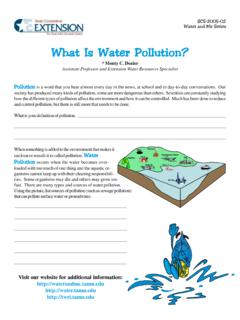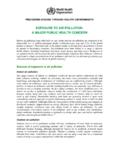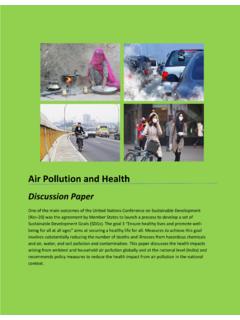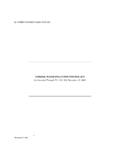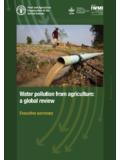Transcription of An Introduction to Air Pollution – Definitions ...
1 Daly, A. and P. Zannetti. 2007. An Introduction to Air Pollution Definitions , Classifications, and History. Chapter 1 of AMBIENT AIR Pollution (P. Zannetti, D. Al-Ajmi, and S. Al-Rashied, Editors). Published by The Arab School for Science and Technology (ASST) ( ) and The EnviroComp Institute ( ). Chapter 1 An Introduction to Air Pollution Definitions , Classifications, and History Aaron Daly and Paolo Zannetti The EnviroComp Institute, Fremont, CA (USA) and Abstract: Definitions and classifications used in the study of air Pollution are introduced. Also introduced are a brief history of air Pollution , its regulation, and trends of its ambient concentrations and emissions.
2 Keywords: Anthropogenic, biogenic, geogenic emissions; primary and secondary pollutants; criteria, hazardous, radioactive, indoor pollutants; sulfur smog, photochemical smog; UN-ECE, US-EPA, Clean Air Act. 1 The Natural Environment and Some Definitions of Air Pollution The present-day atmosphere is quite different from the natural atmosphere that existed before the Industrial Revolution (circa 17601), in terms of chemical composition. If the natural atmosphere is considered to be clean , then this means that clean air cannot be found anywhere in today s atmosphere. The chemical composition of the pre-industrial ( , before the 18th century), natural global atmosphere is compared to current compositions in Table 1: 1 Ashton, The Industrial Revolution, 1760-1830, London: Oxford University Press, 1948.
3 2007 The Arab School for Science and Technology (ASST) and The EnviroComp Institute 1 2 Ambient Air Pollution Table 1. Atmospheric Chemical Compositions2. Gas Symbol Percent by volume (Current Atmosphere) ppm (Natural Atmosphere) ppm (Current Atmosphere)Nitrogen Oxygen Argon Ar Neon Ne Helium He Krypton Kr Xenon Xe Carbon dioxide CO2 CH4 oxide N2O
4 Vapor H2O Variable ( to 4) Defining air Pollution is not simple. One could claim that air Pollution started when humans began burning fuels. In other words, all man-made (anthropogenic) emissions into the air can be called air Pollution , because they alter the chemical composition of the natural atmosphere. The increase in the global concentrations of greenhouse gases CO2, CH4, and N2O (shown in Table 1), can be called air Pollution using this approach, even though the concentrations have not found to be toxic for humans and the ecosystem. One can refine this approach and only consider anthropogenic emissions of harmful chemicals as air Pollution .
5 However, this refined approach has some drawbacks. Firstly, one has to define what harmful means. Harmful could mean an adverse effect on the health of living things, an adverse effect on anthropogenic or natural non-living structures, or a reduction in the air s visibility. Also, a chemical that does not cause any short-term harmful effects may accumulate in the atmosphere and create a long-term harmful effect. For example, anthropogenic emissions of chlorofluorocarbons (CFCs) were once considered safe because they are inert in the lowest part of the atmosphere called 2 Builtjes, P. (2003) The Problem Air Pollution .
6 Chapter 1 of AIR QUALITY MODELING Theories, Methodologies, Computational Techniques, and Available Databases and Software. Vol I Fundamentals (P. Zannetti, Editor). EnviroComp Institute ( ) and Air & Waste Management Association ( ). 3 #cd4 #m5 #n2o1 An Introduction to Air Pollution 3 the troposphere. However, once these chemicals enter the stratosphere, ultraviolet radiation can convert them into highly reactive species that can have a devastating effect on stratospheric ozone. Similarly, anthropogenic CO2 emissions from combustion processes were considered safe because they are not toxic, but the long-term accumulation of CO2 in the atmosphere may lead to a climate change, which could then be harmful to humans and the ecosystem.
7 Another drawback of this approach is that it does not consider natural emissions as air Pollution even though they can be very harmful, such as gases and particles from volcanic eruptions, and smoke from forest fires caused by natural processes (lightning strikes). So besides anthropogenic emissions, it is useful to also consider geogenic emissions and biogenic emissions as contributors to air Pollution . Geogenic6 emissions are defined as emissions caused by the non-living world, such as volcanic emissions, sea-salt emissions, and natural fires. Biogenic emissions come from the living world; such as volatile organic compound (VOC) emissions from forests and CH4 emissions from swamps7.
8 Human activity can also influence geogenic and biogenic emissions. For example, human applications of nitrogen fertilizers in agriculture can result in increased biogenic emissions of nitrogen compounds from the soil. Also, humans can affect the biogenic emissions of VOC by cutting down trees or planting trees. Lastly, geogenic emissions of dust from the earth s surface can be altered if the surface is changed by human activity. So taking all of the above into account, we can define an air pollutant as any substance emitted into the air from an anthropogenic, biogenic, or geogenic source, that is either not part of the natural atmosphere or is present in higher concentrations than the natural atmosphere, and may cause a short-term or long-term adverse effect.
9 2 Primary and Secondary Pollutants Pollutants can be classified as primary or secondary. Primary pollutants are substances that are directly emitted into the atmosphere from sources. The main primary pollutants known to cause harm in high enough concentrations are the following: Carbon compounds, such as CO, CO2, CH4, and VOCs Nitrogen compounds, such as NO, N2O, and NH3 Sulfur compounds, such as H2S and SO2 6 7 Builtjes, P. (2003) see previous footnote. 4 Ambient Air Pollution Halogen compounds, such as chlorides, fluorides, and bromides Particulate Matter (PM or aerosols ), either in solid or liquid form, which is usually categorized into these groups based on the aerodynamic diameter of the particles8,9: 1.
10 Particles less than 100 microns, which are also called inhalable 10 since they can easily enter the nose and mouth. 2. Particles less than 10 microns (PM10, often labeled fine in Europe). These particles are also called thoracic since they can penetrate deep in the respiratory 3. Particles less than 4 microns. These particles are often called respirable 12 because they are small enough to pass completely through the respiratory system and enter the bloodstream. 4. Particles less than microns ( , labeled fine in the US). 5. Particles less than microns ( , ultrafine ). Sulfur compounds were responsible for the traditional wintertime sulfur smog in London in the mid 20th century.
